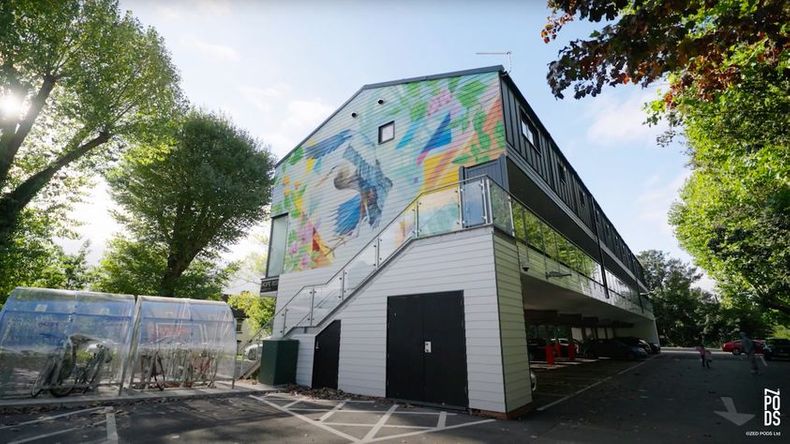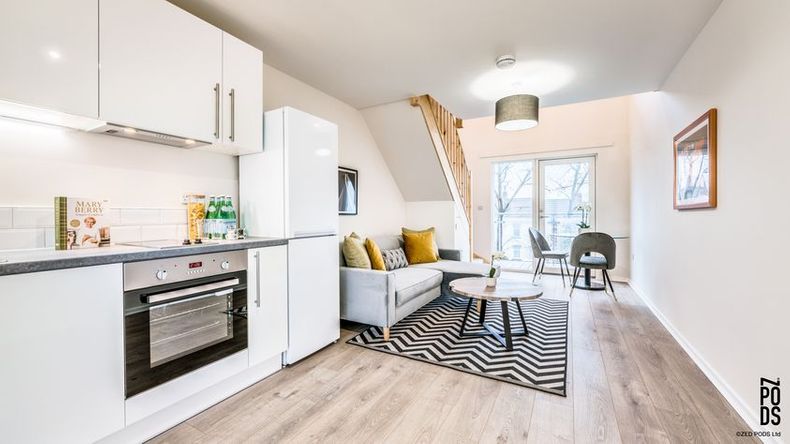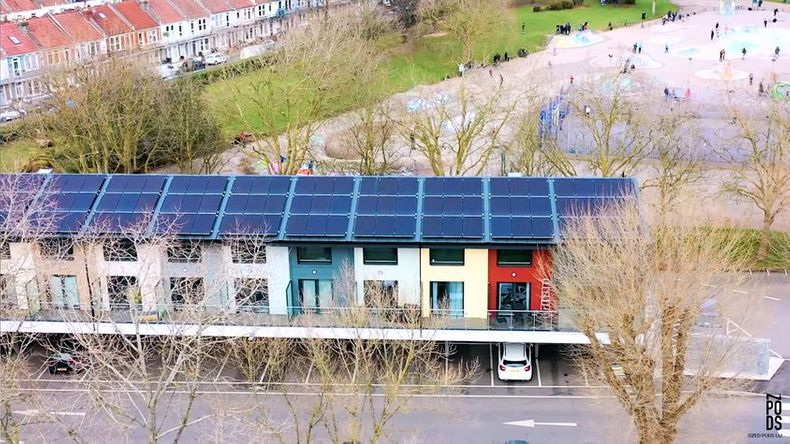Winner and Project of the Year
Hope Rise
Words by ZED PODS Limited
ZED PODS is the UK-leading modular housing company with a big mission: to address social inequality in housing and contribute towards reducing the impacts of climate change in the construction sector. We do this by providing innovative zero-carbon modular housing solutions on constrained brownfield sites, including derelict garage sites, carparks, infills and flood zones.
Hope Rise is an environmentally and socially focused development that has provided much-needed council housing in St George for young adults in need of affordable accommodation and those at risk of housing crisis. Completed in December 2020, in January 2021 residents moved into what are the first offsite Modern Methods of Construction (MMC) homes of their kind completed in the UK. This ground-breaking net zero-carbon development of eleven residential homes, delivered through a unique collaboration and partnership between the Bristol City Council, Bristol Housing Festival, and YMCA, is an example of innovative sustainable development above an existing public car park.
Creative land use is the central feature of our modular housing solutions. In this project, the design features a steel platform constructed above an operational council-owned car park. The project also includes enhancements to the car park layout and the addition of associated works, such as EV charging facilities, all while retaining the full complement of public parking spaces. The scheme was part of the Transforming UK Construction programme, funded by Innovate UK, which aimed to understand the challenges and risks of “going first” for innovative projects using MMC. Traditional build methods would not work on this scheme.
The completed modules were installed over a weekend, resulting in minimal disruption to the local community and traffic. The speed of construction has led to reduced disruption, noise, pollution, and carbon footprint. As a result, Hope Rise was the first scheme to be completed and handed over to Bristol City Council, among eight other demonstration projects in Bristol. It was UK’s first 100% affordable, zero-carbon-in- operation scheme built above a steel podium. This project has fundamentally changed how local authorities approach land-use in the fight to overcome the social housing crisis in the UK.
Hope Rise prioritises the health and well-being of its occupants through low-carbon design, sustainable practices, and community-oriented approaches. All homes are open floor plans and dual aspect, with large triple-glazed windows maximising natural daylight and airflow to create bright and airy homes. Residents enjoy 5sqm+ outdoor private balconies, which opens out to a grand view, encouraging outdoor living and recreation. Each home is equipped with built-in storage space, complemented by a secure cycle store located in communal area.
Sustainability and Climate Change Abatement was at the heart of the scheme design and our operations. We extended this to all elements of our production for this project. We consciously selected non-toxic, low-VOC, durable materials and sourced locally where possible, minimising embodied carbon throughout the supply chain and at every stage of the building lifecycle. Sound-absorbing insulation and strategic layout create quiet and peaceful living spaces. The residents have found that once in their homes they are entirely unaware of the car park. The form of MMC construction meant that the buildings was completed more than 90% offsite. Strict zero-waste-to-landfill policy was implemented in the factory during the offsite manufacturing process of modules. All these benefits enable carbon payback within the lifetime of buildings.
The environmental performance of these modular dwellings was critical in securing planning for this innovative development. We incorporated insights from Passivhaus, LETI, and UKGBC into our energy and fabric model to deliver this innovative zero-operationalcarbon scheme that encompasses both operational and embodied carbon considerations. The homes have been designed and to be both highly energy efficient and net zero-carbon in operation, to secure residents the lowest possible running costs. Energy bills average £46per calendar month for the one-bed apartments.
Hope Rise also has roof-mounted solar panels to generate renewable electricity in the day, quiet running micro air source heat pumps for low-energy heating, controlled ventilation that recovers usable heat from inside the building (93% heat recovery) whilst bringing in fresh air, triple glazing, LED lighting, and energy efficient appliances. The dwellings have no gas connections, eliminating impact on air quality. Applying a fabric-first approach, the modules achieved high airtightness and, when solar panels are added onto each dwelling, they produce more energy than they consume, making them true energy positive homes.
The 105 roof-mounted photovoltaic panels (30.4 kWp) generate enough energy to cover the yearly demands of residents and provide surplus power to the national grid. Some residents are currently benefitting financially from their solar panels; this onsite electricity generation is making the whole development carbon negative in operation. The homes are monitored for temperature, humidity, CO2 levels, and electricity usage. In 2021, we partnered with the University of West England (UWE) to conduct the “Post Occupancy” evaluation, energy monitoring, and follow-up customer satisfaction surveys. The Energy usage analysis in the report validated that 104% of annual energy usage was generated onsite by the roof solar panels, making this development net zero-carbon in operation.
As the pilot project, Hope Rise has been extraordinarily successful in unlocking subsequent development schemes. Off the back of this multiaward- winning development of 11 homes, we have now unlocked 400 more sustainable homes in the Southwest region and have a pipeline of around 1,200 homes.
“We are a city with big ambition, and delivering affordable homes is at the heart of this,” Cllr Tom Renhard, Cabinet Member for Housing Delivery and Homes, Bristol City Council, said in May 2022. Hope Rise was the first of its kind in the UK, including the first ZED POD project utilising air-rights to deliver affordable housing for young people in housing need. Innovation is not easy, but essential as we seek to deliver homes fit for the future, today.
Sam Lindo, Resident of Hope Rise and a Community Builder for the scheme, said, “I was nervous about moving in so close to Christmas because of winter. Most people I know, when they first move in, it’s always cold. However, the homes are really warm and don’t take long to heat up. I fell in love with ZED PODS at first read. I loved that they are energy-efficient and environmentally friendly.”
Entry boards
Judges' comments
Hope Rise provides a much needed move on accommodation for young adults through use of great design and Architectural Technology. This net zero-carbon development is a creative use of land, utilising the air rights above an operational car park to create much needed new homes without displacing existing infrastructure. They are the first factory-built steel frame modular homes of their kind to be completed in the UK. Being 90% constructed within the factory, the timescales from concept to completion was within two years with an impressive onsite construction of only two days. The judges were impressed with the overall package of detailed design and construction, speed of delivery on site, sustainability credentials and post occupancy evaluation, making this the worthy winner.



